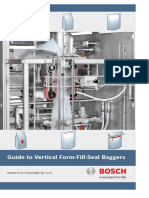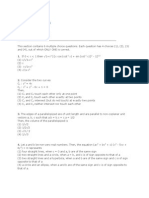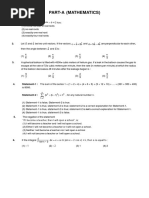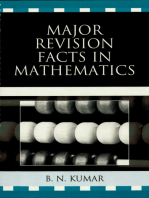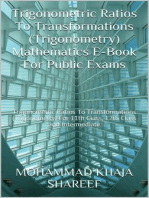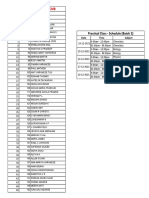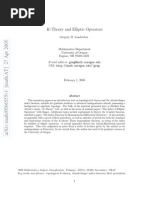IIT Mathematics 2005
IIT Mathematics 2005
Uploaded by
Robin SinghCopyright:
Available Formats
IIT Mathematics 2005
IIT Mathematics 2005
Uploaded by
Robin SinghOriginal Description:
Copyright
Available Formats
Share this document
Did you find this document useful?
Is this content inappropriate?
Copyright:
Available Formats
IIT Mathematics 2005
IIT Mathematics 2005
Uploaded by
Robin SinghCopyright:
Available Formats
Mathematics
Time: 2 hours
Note: Question number 1 to 8 carnes 2 maries eaCh, 9 to
6 marks each.
and
-ij-
y y y
andy
om
A persoogoes to office either by car, soooter, bus or traon probability of whoch be1ng
respectively
Probabil~y lhal he reaches office late, If he takes car, scooter, bus or train Is %
i~
respectively Gwen that he reaChed office In tome, then what IS the probability that he travelled
by a car
Sol
marks eaCh and 17 to 18 carnes
Let C, S,
ce
.c
Q1 .
16 carries 4
B. T be the events of the person goong by car, soooter, bus or train respectively.
'
Goven that P(C) =
7 . P(S) = 7 . P(B) = 7 . P(T) = 7
Let [ be the event of 1he person reaChing the office In time
C
p(f)
c)
([ - cP{C)
ra
P(f)=
~9 ' P(c)=
~.
P( c )= !
S
B
9
T
9
=> P( c )=I..
--7
P(C)
=-P--
79
xa
! x Z. + ;! Y ~ +~ ~ ~ +~ , !
7 9 7 9 7 9 9 7
Rnd the range or values oft for wh1ch 2 sin 1=
Sol
Lety =2 sont
1- 2x + 5x 2
so, y=
2
3x - 2x - 1
=> (3y- 5)x2 - 2x(y - 1)- (y + 1) =0
1 2
te
- x+
3x2 - 2x - 1
sx .
[-!,!!:.]
2 2
w
w
.e
Q2.
since X e R -
{t -i}.
SOO <! O
=>l- Y- 1 "'0
or y ., -1+ -.../5
orsin t <!o
1- ./5
andy ,; - 2
1+:
and sin t ,; - .../5
4
[ " "] [3" "]
Hence ra.v.eof
t os - -2 ' - -10 u -10 ' -2 .
..,
Q3,
Circles with radii 3, 4 and 5 touch each other externally If P Is the point of intersection of tangents to
these circles at their points of oontacl Find the distance of P from the points or contact
Sol
Let A, B, C be the centre of lhe three clrcl~.
Clearly the point P IS the 1n-centre of the .6ABC, and
hence
r= t. = ~s(s - a)\s - b)(s -o) = /(s - a)(s - b)(s - o)
s
=7 + 8 + 9 =24 => s =12.
3
Hence r =P~; =./5.
F"md the equallon of the plane containing lhe line 2x - y + l - 3 = 0, 3x t y + z = 5 and at a d1stance of
.~
Sol
From the point (2, 1, - 1 ).
Let the equation of plane be (3:\. + 2)x + (i. - 1 )y + (A. + 1)z - 5). - 3 = 0
GA. -r 'l + i. - 1- 1.. - 1- 51- - 3
2
<:St-+2> + <A. - 1Y + <A. + 1f
=>
-'6
4
G(t- - 1)2 = 1n' + 121.. + G=> 1.." o.- ~
ce
.c
Q4.
om
Now 2s
=> The planes a re 2x - y + z - 3 = 0 and 62>< + 29y + 19z- 105= 0.
2
If lf{x1) - f(x,)l < (x, - x2) , for an x1, x2 e~. F"md the equalton of tangent to the CUJVe y = f(x) at the
polnl(1, 2).
Sol
If (x 1) - f (x2)1 < (x 1 - x2) 2
ra
Q5.
o=> f' (x) = 0
=> lim f(x,) - f(x2 ) < lim I x, - x2 1 => If' (x)l <
x,-x,
><, - x2
x,- x2
Q6.
xa
Hence f (x) Is a constant function and P (1, 2) lies on the cuiVe
=> r (x)" 2 is the curve.
Hence the equation of tangent IS y - 2 = 0.
1
If total number or runs scored 1n n matches IS ( "; ) (2"1- n - 2) where n > 1, and the runs scored
.e
In the I<"' maioh aregllien by i<. 2..,.., where 1 s k s n Ffnd n
s. ,. })<. 2- = 2"' ' L k z- .. 2"'1.2[1--1-~]
n
Let
w
w
Sol
k l
2"
2"-'
(sum of the AG P.)
= 2{2"., - 2 - n]
n+ 1
=> -
= 2 = n 7
The area of lhe tnangle formed by !he intersection of a line parallel to X BXIS and pasSing through
P (h, k) wilt! the lines y x and x + y ., 2 1s 4h 2 Find the toous of the point P.
Q7.
Sol.
Area or triangle =~ . AB. AC -= 4h2
and AS =
2
=> 4h
=~
.fi IK- 11= AC
2. (k - 1)2
=> k - 1 " 2h
=locus lsy = 2x + 1, y = - 2x+ 1.
le~<ul 2sin(~cosx) 3cos(~cosx
QB.
Evaluate
So l
(2sln' 1cosx \ +3oos(1
I= Jel'""l
-cos x 1s;n x dx
)1
112
e" SlllXCOS
)) sin x dx
H,~
(1
)
2cosx dx
0.
Letcosx = 1
oos(~)dt
I= 6 e'
Q9.
~4 ( ecosG) +~sin(~)-1)
i 1(2a x)
l(x)
Incident ray IS along the l.l'lR wctor v and the reflected ray os
.;
w
l.l'lit vectorw . The normal 1s along ur1t vec10r a
outwards Express
In terms or a and v
;z ~......,;;
along the
Y IS l.l'lll vector along the IOCidenl ray and W
Is the ll'lll vector along the reflected ray
Hence 6 os a unit vector along the extemal
biSector or v and w. Hence
.. i
ra
Sol
-I(X)l
ce
.c
tf f(2a- X) -
om
w- v- M
~ 1 1 -wv = 1.2
or2 -2cos 26 = 'A1
or), a 2 sin I)
w,
xa
where 20 IS the angle between and
Hence w- v = 2stMa = 2cos(90 o)S - (2ii. v)i
=>
v 21a . v)a
TallJeniS are drawn from any potnt on the hyperbola
.e
Q 10.
locus or med-potnt or the chord of contact
x2
Anf point on the hyperbola
w
w
Sol
or
y2
xl
Y = 1 to the ctrcle x2 + y2 9 Find the
4
= 1 IS (3 sec6, 2 taM)
9 4
Cttord oorcact the crcle x' +of= 9 With respec1 to the point (3 sec e. 2tan O) ts
3 sec9 x + 2 taM y = 9
(1)
Let (x,, y,) be the mtd-pomt of the chord of oontact
" equauon ol chord In mid- potnt form is xx, + yy, )(,2 + y,
(2)
Stnce (1) and (2) represent the same line,
3sec(J 21an&
9
or
-- -
:3
x,
sece
Hence
Y1
x1 .,. y,
9x1
tan& =
3(x,2 +Y,>} '
81x12
9y 1
2(x12 t
81y12
2
2
9(x12 ~ v/) 4 (x1 +
x2
=> the reqUired locus ts -
y/)
y1 )
1
y2 l x2+y2 ' 2
- -
Q11 .
Find the equauon of the common tangent in 1" quadrant to the circle
X~
25
Sol
y~
+"4 = 1
X: + y2 = 16 and the eUipse
Also find the length of the intercept ofthe tangent belween the coordinate axes
Let the equations of tangents to the given circle and the ellipse respectively be
4~1 + m' = ~2f>m2 + 4
=>
16{1 + m1 =25m2 + 4
=>m = t .3..
../3
The tangent is at a point in the first quadrant => m < 0
y=
-Js .
so that the equabon of the common tangent is
- }Jx-t4~
It meets the coordinate axes at A ( 2.fi, 0) and
a(
0,
4~)
ra
=> AB =~
ce
.c
=> m =
om
y = mx + 4~1+ m2
2 -+and y = mx + ,Jr2-5m-::4
Since both of these represent the same common tangent,
.,f3
If length of tangent at any polfll on the curve y = f(x) intercepted between the point and the x-axis Is or
length 1 Flncl the equation of the curve,
so1
Lengthortangent =
Q12.
v}+(:rl=>1 v'[1+(: r]
xa
v
= -dy
= R
dx
- y~
=> I R-y
dy -X+C
.e
Wnling y = s1n e, dy = cos l:l dl'f and mtegrating, we get the equation ol the curve as
+ ln~1 - J~-y2
>=X+ C.
w
w
J1 - y2
Q13.
FJnd the area bounded by the curves x2 = y, x2 = -y and y2 = 4x- 3.
Sol
The reg10n bounded by lhe g1ven curves
x2 = y, x'= - y andy'= 4x - 3 is
symmetrical about the x-axls. The parabolas
andy' = 4X - 3 touch at the po1nt (1 1J
Moreover the vertex or lhe cu!Ve
2
y = 4x - 3isat
x' = y
(%0)
Hence the area of the reg10n
2[Jx~dx - j .J4x - 3ctx]
0
3/-4
- -1((4x - 3)''')' ] = 2[1
- - -1]= -1. sq unll$
[( )(3)'
3 0 6
3 6
3
=2 -
31.
Q14.
lr one of the vertlces or the square c1roumsctiblng the e~role IZ - 11 = ../2 Is 2 +
vertices of square.
Sol.
Since centre of circle I.e, (1, OJ Is also the
rriG-polnt of dtagonals of square
z, +z,
2
z. - 1
= Zo => Zz = -.fii
.. /'
and - - = e""
Zj -1
::::> other vertices are
z.. z.o = (1- J3)+ i and (1 + ,/3)-1.
om
=>
J3 L Find the other
Q16.
If F(x - y) I (x). g (YJ - f (y). g (x) and 9 (X- y) g (X) g (y) + I ()(). I (y) for all X, y
derivative at x = 0 exists for r (x). Find derivative or g (x) at x = o.
Sol.
I (X - y) = f (x) g (y) - f (V) 9 (X)
R If right hand
ce
.c
-- (1)
Putx = yIn (1), we get
f (0) = 0
puty = 0 in (1), we get
I!
9 (0)" 1
Now, I' (Ol = lim f(O+ h) - 1(0) = lim f(O)g(- h) - g(O)f(-h) - 1(0)
-o-
~o
ra
= IJm f(-h)
(: f (O) = O)
~o - h
,. llfn f(O- h) - f(O)
-h
= r (O/.
Hence r (x) is d1fferertiable at x = o.
Put y = X in g
y) = 9 (X). 9 (y) + f (x). f (y)
Also f' (X) + 9 (X) = 1
=> g' (l<) = 1 -f (X)
=> 2~ (OJ g (0) =- 2f (OJ f (0) = 0 => g' (0) = 0,
.e
If p(x) be a polynomial of degree 3 satisfying p(-1) = 10, p(1) = - 6 and p(x) has maximum at x = - 1
and P'(X) has minima at x = 1. Find the distance between the local maximum and local mimmum of the
CUIVe.
Sol
xa
lX -
-o-
Q16.
Let the polynomial De P (x) = ax3 + bx' +ex + d
w
w
According to given conditions
P(-1)= -a + b-e + d = 10
P(1) =a + b+ C+d =~
AlsoP' (- 1) = 3a - 2b+c = 0
and P'" (1) = 6a + 2b = 0 = 3a + b = 0
Solving for a, b, c. d we get
P (x) = x3 - 3x' - 9x + 5
=> P' (x)= 3x'- 6X -9= 3(x+ 1)(x - 3)
=> x = - 1 is the point of maximum and x = 3ls the point or minimum.
Hence distance between (-1, 10) and (3, -22) is 4./65 units
Q17.
f(X) Is a dillerenliable function and g (x) Is a double differentiable function such that Jf (X)I s 1 and
f (x) = g ()(). II f (OJ + g' (OJ = 9. Prove that there exiSts some c e (- 3, 3) such that g (c). g"(c)< 0.
Sol
Let us suppose I hat both 9 (X) and 9" (x) are posftive for all x e (- 3, 3)
S1noe r7 (OJ+ g' (OJ= 9 and - 1 ~ r (x) ~ 1, 2../2 , g (OJ , 3
From f (x) = g ()<), we get
f (x) =
Jg(x)dx + f (-3)
-a
Moreover, go (x) is assumed to be positive
=> the curve y = g (~) is open upwards.
If g (x) Is decreasrng, lhen for some value of x
.J2 " 3 -
1 i.e. r (x) > 1 which is a contradiction
If g (x) Is Increasing, for some value or x
=> r (X) > 2 ../2 " 3 - 1 I.e
II g(x) is minimum at x :
Jg(x)dx > area or lhe rectangle (3 - 0))2 ./2
r (x) > 1 which is a oonlradlctlon.
Jg(x)dx
o then
om
:::> r (x) > 2
Jg(x)dx >area of the rectangle (0- (-3))2 .J2
> area ollhe rectangle (3- 0)2
-3
=r (x) > 2 ./2 " 6 - 1 i.e r (x) > 1
./2
ce
.c
which is a contradiction
Hence g (x) and g (x) caMOt be both positive throughOut the Interval (-3, 3).
Simrlarty we can prove that g(x) and g(x) cannot be both negative throi(Jhout the interval (-3, 3)
Hence there is atleast one value of o e (- 3, 3) where g (x) and 9" (x) are or opposite sign
= g (c) rt (c) < 0.
Altemate:
Jg(x)dx = Jf'(x)dx = r (3)- r(0)
0
0
l
--
g(x)dx < 2
0
Jg(x)dx < 2
In the same way
-3
'
g(X)dx +
...... (2)
xa
.)
(1)
ra
g(X):lX < 4
.... (3)
.e
From (1(0)) + (9 (0)) = 9
we get
2 ../2 <g(0)<3
w
w
or -3 < 9 (0) < -2 ../2
...... (4)
... (5)
Casel :2../2 < g (0) < 3
Let 9 (x) is concave upward v x ( -3, 3) then
the area
g(x)dx +
~ g(x)dx > 6./2
which is a contradiction from equation (3).
:. 9 (x) will be concave doWnward for some c
e (-3, 3) I.e. g (c)< 0 ...... (6)
also at lhat fXlln! c
g (c) will be greater than 2 ../2
g (c) > 0
...... (7)
From equation (6) end (7)
9 (c) rt (c)< 0 for some c e (-3, 3).
',(0, 3)
''
'
Case II: -3 < g (0) < -2 .fi
l et g (x) IS coocave downward
then the area
l g(x)dx
v x (- 3, 3)
(3, 0)
+~ g(x)dx " s.fi.
ce
.c
om
which is a cootradiction from equation (3).
: . g (x) will be concave up.vard for some
c e (-3, 3) l e. g (c) " o
.. (6)
also at that po1nt c
g (c) will be less than -2 .f2
=> g (c) < 0
. (9)
From equation (8) and (9)
g (c) g" (c)< o for some c e (-3, 3).
Q18. If[:: : ~][':~;)]=[!~ :~:]. Isa
f(x)
4ea
1(2)
4e 1
quadratic function and its max1m1.111 value occurs at a
3c2 ~ 3c
point V A IS a pomt of Intersection of y = f (x) with x-ax1s and point B iswoh that chord AB subtendS a
nght angle at V. Find the area enclosed by f (x) and chord AB.
ra
Let we have
4a2 f(-1) + 4a 1(1) + f (2)= 3a' +3a
(1)
4b2 f(-1) + 4b 1(1) + f (2) = 3b2 + 3b
(2)
4e 2 f (-1) + 4cf (1) + 1(2) = 3c2 ... 3c
(3)
Consider a quadrabo equabon
2
2
4x f (-1) + 4X f ,1) + f(2) = 3x + 3x
orj4f (-1)-3J x +(41(1)-3Jx+f(2)= 0
(4)
As equation (4) has three roots I.e. x " a, b, c. It Is an identity.
xa
Sol
=>I HJ= -;;-. 1(1) =
'43
and f(2)=0
(4 x2 )
(5)
4
2
l et point A be (-2, 0) and B be (21, - t + 1)
Now as AB subtends a rtght angle at the venex
v (0, 1)
w
w
.e
=> r (x) "
1 - 12
- x=-1= 1= 4
2 21
=> B = (6, - 15)
-r
J(4-x 3x+6L
8
:. Area= _
- -t -
125
sq. units
v(o,11
You might also like
- Worksheet A Topic 3.1 Periodic PhenomenaDocument4 pagesWorksheet A Topic 3.1 Periodic PhenomenaAlaska Yoon0% (1)
- Bosch Guide To Vffs-WebDocument90 pagesBosch Guide To Vffs-WebRathnakar Reddy100% (4)
- Iit Jee 2005 MatDocument7 pagesIit Jee 2005 MatLokesh KumarNo ratings yet
- HPI-6 Coordinate Geometry & IntegralDocument18 pagesHPI-6 Coordinate Geometry & Integralusaha779No ratings yet
- Maatthheem Maattiiccs: FI Iiit TJ JEDocument5 pagesMaatthheem Maattiiccs: FI Iiit TJ JEheroNo ratings yet
- Exercise 1.0 (Main)Document14 pagesExercise 1.0 (Main)rockydalabehera94No ratings yet
- M55 LE1 Review HandoutDocument33 pagesM55 LE1 Review HandoutMikayla LopezNo ratings yet
- 102HW5 09 SolDocument6 pages102HW5 09 SolShawn SagarNo ratings yet
- 2nd Unit Test Q&A BankDocument6 pages2nd Unit Test Q&A BankatharvpatilinfoNo ratings yet
- Iit 2008Document34 pagesIit 2008skbothNo ratings yet
- G13 1941 PUTNAM Web SolutionDocument15 pagesG13 1941 PUTNAM Web SolutionmokonoaniNo ratings yet
- Circles ImpDocument9 pagesCircles ImpSyed SalmanNo ratings yet
- Fitjee Test Paper of MathDocument11 pagesFitjee Test Paper of Mathsudhir_kumar_33No ratings yet
- Detailed Solutions A-07 JUNE 2003: I X X F F IDocument32 pagesDetailed Solutions A-07 JUNE 2003: I X X F F IAdzLinkBalaoangNo ratings yet
- Midterm 100 SolDocument6 pagesMidterm 100 Solsfluk2No ratings yet
- Vectors & 3DDocument100 pagesVectors & 3DmanishNo ratings yet
- Topper 8 103 10 18 Test Resources 2012 Questions Up201506182058 1434641282 7406Document16 pagesTopper 8 103 10 18 Test Resources 2012 Questions Up201506182058 1434641282 7406SourabhNo ratings yet
- 10 04 Angle Between Two Curves PDFDocument15 pages10 04 Angle Between Two Curves PDFSri DNo ratings yet
- Midterm Exam of Math100 (All Lecture Sections, Fall 2008) : A B A BDocument2 pagesMidterm Exam of Math100 (All Lecture Sections, Fall 2008) : A B A Bsfluk2No ratings yet
- Iit Jee 2004 MathDocument7 pagesIit Jee 2004 MathLokesh KumarNo ratings yet
- AC 1.1-MathDocument197 pagesAC 1.1-MathsatydevsinghnegiNo ratings yet
- Generalized Fibonacci Tiling: Theorem 1Document9 pagesGeneralized Fibonacci Tiling: Theorem 1Charlie PinedoNo ratings yet
- G13 1948 PUTNAM Web SolutionDocument10 pagesG13 1948 PUTNAM Web SolutionmokonoaniNo ratings yet
- THE Computation of Derivatives: Cálculos de DerivadasDocument5 pagesTHE Computation of Derivatives: Cálculos de DerivadasRaul Humberto Mora VillamizarNo ratings yet
- MIT Multivariable Calculus Exam A SolutionsDocument16 pagesMIT Multivariable Calculus Exam A Solutions15klaNo ratings yet
- Multivariable Calculus Sample ExamDocument5 pagesMultivariable Calculus Sample ExamFaithBoaz21No ratings yet
- SMO 2010 Open SolutionDocument11 pagesSMO 2010 Open SolutionwmdsgNo ratings yet
- Kcet - Mathematics - 2016: Version Code: C - 3Document13 pagesKcet - Mathematics - 2016: Version Code: C - 3Kamalesh Shenoy100% (1)
- Legendre PolynomialsDocument6 pagesLegendre PolynomialsFrancis Jr CastroNo ratings yet
- Conic SectionDocument28 pagesConic Sectionrajatbansal427100% (1)
- Iitjee 2004 MathDocument7 pagesIitjee 2004 MathKitti WongtuntakornNo ratings yet
- 1b Important QuestionDocument4 pages1b Important QuestionÇháråñ ÇhèrryNo ratings yet
- Review Exam MATH Questions and AnswersDocument73 pagesReview Exam MATH Questions and AnswersheelchristianNo ratings yet
- Maths Model Test Paper For Summative Assessment - 1Document13 pagesMaths Model Test Paper For Summative Assessment - 1Apex InstituteNo ratings yet
- STPM Trials 2009 Math T Paper 1 Answer Scheme (Kelantan)Document9 pagesSTPM Trials 2009 Math T Paper 1 Answer Scheme (Kelantan)Jessica JonesNo ratings yet
- Aieee Paper 2008Document30 pagesAieee Paper 2008Ravi LorventNo ratings yet
- Universiti Teknologi Malaysia: (This Question Paper Consists of 10 Printed Pages Including This Page)Document10 pagesUniversiti Teknologi Malaysia: (This Question Paper Consists of 10 Printed Pages Including This Page)Amirul AizatNo ratings yet
- Hwang 1973Document8 pagesHwang 1973FlorinNo ratings yet
- Team Round SolutionsDocument3 pagesTeam Round SolutionshungkgNo ratings yet
- RT Solutions-22!01!2012 XIII VXY Paper II Code A SolDocument16 pagesRT Solutions-22!01!2012 XIII VXY Paper II Code A Solvishal110085No ratings yet
- "Just The Maths" Unit Number 8.6 Vectors 6 (Vector Equations of Planes) by A.J.HobsonDocument10 pages"Just The Maths" Unit Number 8.6 Vectors 6 (Vector Equations of Planes) by A.J.HobsonDaniel BoenfieNo ratings yet
- Circle OnlyDocument44 pagesCircle OnlyTapas BanerjeeNo ratings yet
- First Pre-Board Examination 2014-15: Subject: Mathematics Class-Xii TIME: 3hrs MM:100Document7 pagesFirst Pre-Board Examination 2014-15: Subject: Mathematics Class-Xii TIME: 3hrs MM:100HItesh PatreNo ratings yet
- AodDocument41 pagesAodAditya BansalNo ratings yet
- STPM Trials 2009 Math T Paper 1 (SMJK Sam Tet Ipoh)Document2 pagesSTPM Trials 2009 Math T Paper 1 (SMJK Sam Tet Ipoh)Vincent MokNo ratings yet
- 3:3Document15 pages3:3Nicholas CemenenkoffNo ratings yet
- Solutions Manual To: An Introduction To Mathematical Finance: Options and Other TopicsDocument65 pagesSolutions Manual To: An Introduction To Mathematical Finance: Options and Other TopicsHanh VuNo ratings yet
- Fiitjee Mock PaperDocument25 pagesFiitjee Mock PaperShashank ShekharNo ratings yet
- SphereDocument15 pagesSphereSiddharth Mayya100% (1)
- Chapter 11Document14 pagesChapter 11Miku Fourier AlvaradoNo ratings yet
- Application of Derivatives Theory - eDocument41 pagesApplication of Derivatives Theory - ethinkiitNo ratings yet
- TangentsDocument22 pagesTangentsAPS Apoorv prakash singhNo ratings yet
- Application of Derivatives Tangents and Normals (Calculus) Mathematics E-Book For Public ExamsFrom EverandApplication of Derivatives Tangents and Normals (Calculus) Mathematics E-Book For Public ExamsRating: 5 out of 5 stars5/5 (1)
- Transformation of Axes (Geometry) Mathematics Question BankFrom EverandTransformation of Axes (Geometry) Mathematics Question BankRating: 3 out of 5 stars3/5 (1)
- Analytic Geometry: Graphic Solutions Using Matlab LanguageFrom EverandAnalytic Geometry: Graphic Solutions Using Matlab LanguageNo ratings yet
- Trigonometric Ratios to Transformations (Trigonometry) Mathematics E-Book For Public ExamsFrom EverandTrigonometric Ratios to Transformations (Trigonometry) Mathematics E-Book For Public ExamsRating: 5 out of 5 stars5/5 (1)
- Applications of Derivatives Errors and Approximation (Calculus) Mathematics Question BankFrom EverandApplications of Derivatives Errors and Approximation (Calculus) Mathematics Question BankNo ratings yet
- De Moiver's Theorem (Trigonometry) Mathematics Question BankFrom EverandDe Moiver's Theorem (Trigonometry) Mathematics Question BankNo ratings yet
- Mobile application developmentDocument52 pagesMobile application developmentRobin SinghNo ratings yet
- Lecture 24Document1 pageLecture 24Robin SinghNo ratings yet
- Lecture 14Document1 pageLecture 14Robin SinghNo ratings yet
- MIT2 017JF09 ch10Document11 pagesMIT2 017JF09 ch10Robin SinghNo ratings yet
- 3.15 Transformers and DC Motors References:: H.DL NiDocument2 pages3.15 Transformers and DC Motors References:: H.DL NiRobin SinghNo ratings yet
- Abstract-Volume-last Version PDFDocument121 pagesAbstract-Volume-last Version PDFClaudio Andres Suarez AuthievreNo ratings yet
- Procaccia Strangeness of AttractorsDocument20 pagesProcaccia Strangeness of AttractorsburisergNo ratings yet
- HKDSE Mathematics Paper 1 Compulsory Part (Conventional Questions)Document6 pagesHKDSE Mathematics Paper 1 Compulsory Part (Conventional Questions)gursimranNo ratings yet
- Simulation of Ultrasonic Guided Wave Inspection in CIVA Software PlatformDocument10 pagesSimulation of Ultrasonic Guided Wave Inspection in CIVA Software PlatformMohsin IamNo ratings yet
- Batch 2 - Students List: Board Practical Exam - BIOLOGY (Tentative)Document1 pageBatch 2 - Students List: Board Practical Exam - BIOLOGY (Tentative)Hisham MunnaNo ratings yet
- Covariant Contra VariantDocument6 pagesCovariant Contra VariantbiluvarNo ratings yet
- 8 Slice Ge Lightspeed Ultra SpecsDocument3 pages8 Slice Ge Lightspeed Ultra Specsahmed_galal_waly1056No ratings yet
- Summary Trigident PDFDocument1 pageSummary Trigident PDFgebran sarkisNo ratings yet
- 2002 - Forming Limit of Magnesium Alloy at Elevated Temperatures For Precision ForgingDocument8 pages2002 - Forming Limit of Magnesium Alloy at Elevated Temperatures For Precision ForgingNguyen Hoang DungNo ratings yet
- NTS-W-2 mathDocument11 pagesNTS-W-2 mathzain IshaqNo ratings yet
- Bolle Summer Cat SS21Document41 pagesBolle Summer Cat SS21Muhammad YusufNo ratings yet
- Medical RF ShieldingDocument2 pagesMedical RF ShieldingManas Ranjan PandaNo ratings yet
- Torque LabDocument14 pagesTorque Labapi-359167484No ratings yet
- MSC Chemistry Oct16Document142 pagesMSC Chemistry Oct16Kundan DeoreNo ratings yet
- Types of ResearchDocument6 pagesTypes of Researchmanasmittal1No ratings yet
- K - Theory and Elliptic Operators: Gregory D. LandweberDocument50 pagesK - Theory and Elliptic Operators: Gregory D. Landweberya_laytaniNo ratings yet
- ICSE-X Mathematics_Chap-4 (Linear Inequalities)Document9 pagesICSE-X Mathematics_Chap-4 (Linear Inequalities)LALITH NAIDUNo ratings yet
- Complete: PhysicsDocument8 pagesComplete: PhysicsConcordia Mannargudi100% (3)
- KE and PE Energy Worksheet 2Document3 pagesKE and PE Energy Worksheet 2Den Mas Munawanto NinoNo ratings yet
- Datasheet For MUR1620Document6 pagesDatasheet For MUR1620WarungRobotika Milis100% (1)
- Am2540 - Applied Mechanics Lab Solid Mechanics Lab ReportDocument13 pagesAm2540 - Applied Mechanics Lab Solid Mechanics Lab ReportAditya KoutharapuNo ratings yet
- Test of Integrated Science Process SkillsDocument13 pagesTest of Integrated Science Process SkillsArnulfo Villasfer Santiago100% (1)
- HIPAVE5 OverviewDocument45 pagesHIPAVE5 OverviewTuna YabaNo ratings yet
- Basic Control RulesDocument39 pagesBasic Control RulesMary Joy GaloloNo ratings yet
- M. Tech Part-TimeDocument15 pagesM. Tech Part-Timeamec3264No ratings yet
- Electromagnetic CompatibilityDocument12 pagesElectromagnetic Compatibilityoadipphone7031No ratings yet
- Bell CrankDocument4 pagesBell CrankRajuKumar100% (2)
- INFILTRATIONDocument32 pagesINFILTRATIONMARIEL REYESNo ratings yet

